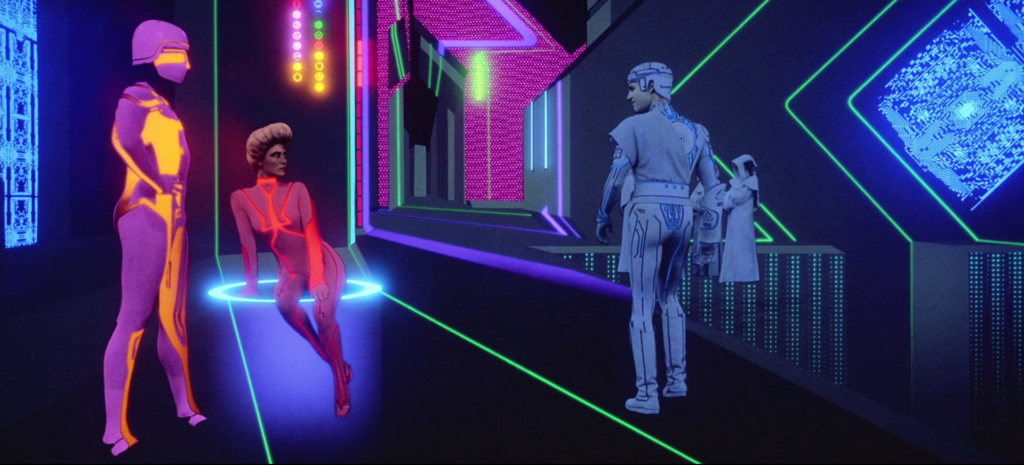When done well, computer generated imagery can allow the filmmaker to achieve results that would be impractical (if not impossible) to recreate by other means.
Done badly, and it can totally undermine an otherwise fine movie.
We could fill an entire post with examples of the latter, but today we’re looking at notable movies that executed computer effects to a superb level, despite the fact that CGI barely existed at the time. And be sure to check out our previous post looking at CGI’s effect on the evolution of special effects.

And we’ll start off with where it all began:
The Vision of an Android (Westworld)
https://www.youtube.com/watch?v=5jCDQvNh85Y
When talking about movies that revolutionized special effects, Westworld is typically the first on the list. The raster graphics used to simulate the titular android’s vision would only take an animation school student fifteen minutes with modern software but it was an entirely different story back in 1973.
Deciding it’d be cheaper than animating the effect from scratch, two computer masterminds instead took the unprocessed footage, separated each frame into tri-color, converted them into blocks, then used a computer to combine it all back together adding basic tone values for each block.
Laborious for sure, but the result is the 2:31 origin of computer-aided effects that you see above. The sequel, Futureworld, also broke new ground by being the first movie to feature a CGI-rendered 3D object (which was actually created four years before its 1976 release):
More interesting still? The gentleman who created that CGI head and hand, Ed Catmull, went on to become the co-founder and president of Pixar.
And speaking of wireframes…
The Trench Run Briefing (Star Wars: A New Hope)
Just after the first appearance of 3D CGI in a movie (and long before Jar Jar Binks arrived on the scene) came an iconic piece of cinema that really got the ball rolling: the briefing scene in which the rebel alliance is coached on how to take out the Death Star, courtesy of some wireframe wizardry.
Here it is in isolation:
Given the extensiveness and detail of the sequence (in 1977, no less) it’s of no surprise that the imagery took weeks of non-stop work to produce at the University of Illinois. Ridley Scott went on to use the same technology in 1979’s Alien, where the Nostromo’s monitors display landing simulations onto the surface LV-426.
But forget CGI being displayed on the odd monitor. Next up, we’ve got a milestone in computer-aided imagery used across an entire movie…
Tron (1982)
CGI animation mixed seamlessly with wireframe graphics, rotoscoping, cel-shading, backlit animation and live action was the order of the day for what was to become a cult favorite.
And it’s a wonder it ever got produced in the first place. So original was the vision for how Tron should look—not to mention how expensive and painstaking it would be to produce—that Disney very nearly passed on the project (especially given that the producer and directors were both first-timers.)
Despite a muddled reception from critics, it did go on to win the Academy Award for Technical Achievement…
…fourteen years after its release.
Not bad given they only had a 2Mb computer with just 330Mb of storage to work with.
CGI progressed onward from this point as computing power increased, with a few attempts to further integrate it into live-action over the 80s. Some were good, some not so good, but it was the nineties that really saw the genesis of CGI as we know it today.
The T-1000 (Terminator 2: Judgment Day)
The go-to example whenever the debate concerning “sequels that are better than the original” crops up at the bar, Terminator 2 got a lot of things right and its use of CGI was one of them.
Of course, we are talking about the visual effects that went into bringing the T-1000 to life; a terrifying nemesis with a liquid metal body that could morph into other shapes (or stab a foster parent through the throat while he’s drinking milk.)
Mimicking liquid is difficult in a computer-generated imagery, as is rendering real-world reflections in metal. Doing both at the same time nearly 30 years ago? That’s cinematic history in the making.
Toy Story (1995)
Very few would have guessed that the first-ever fully-CG feature film would age so well, let alone kickstart an entire industry.
That said, given it was created on a relatively tiny $30 million budget by a very small team (half of whom reportedly didn’t know how to use a computer), it’s a wonder Toy Story ever got off the ground in the first place. This goes doubly so when factoring in the brutal development negotiations between Pixar and Disney, which nearly hamstrung the entire project
And that brings us to the final entry in our round-up of notable early CGI sequences in cinema…
Bullet Time (The Matrix)
Because it’s easy to argue that CGI history can be neatly divided into two eras…
… everything before the Wachowskis’ bullet time, and everything that followed afterward. Join us next time as we look at some of the most remarkable CGI achievements in the post-Wachowski era and please let us know of any movies or moments we forgot to include in the comments below!
